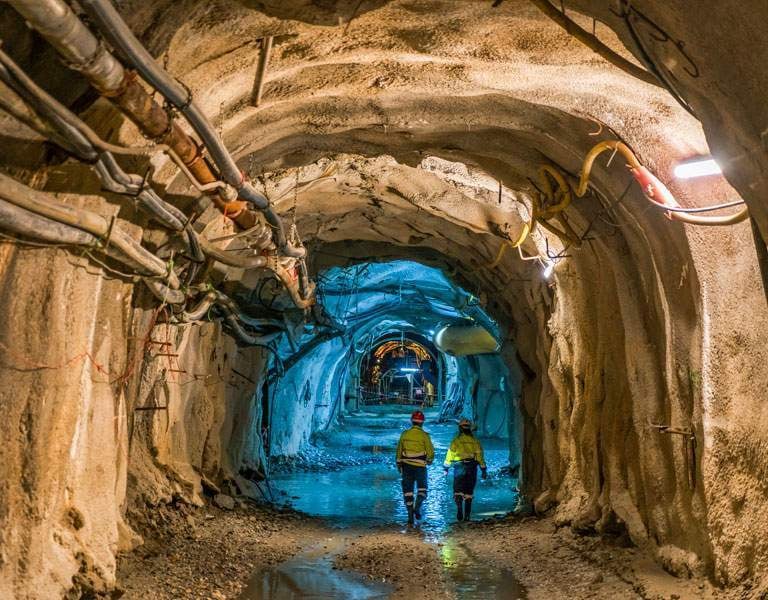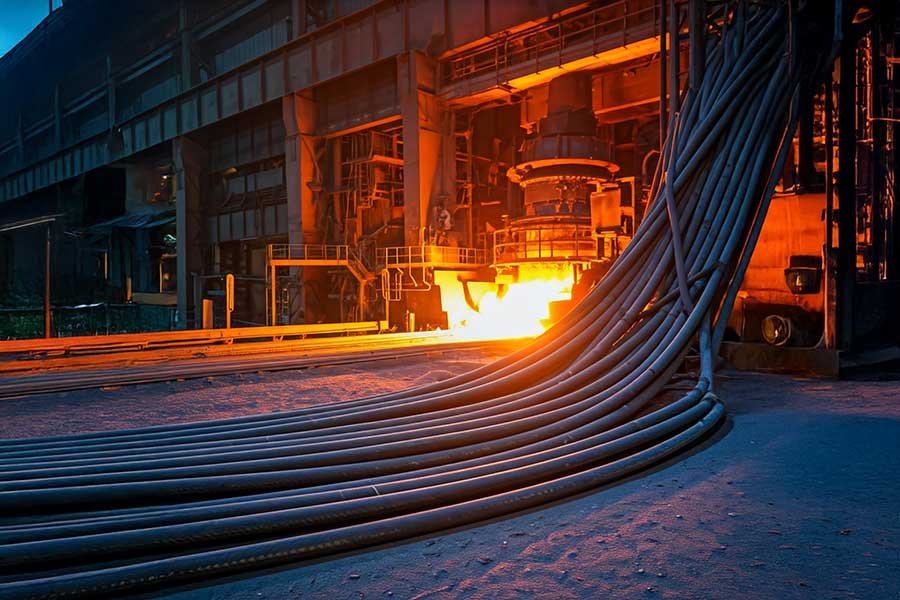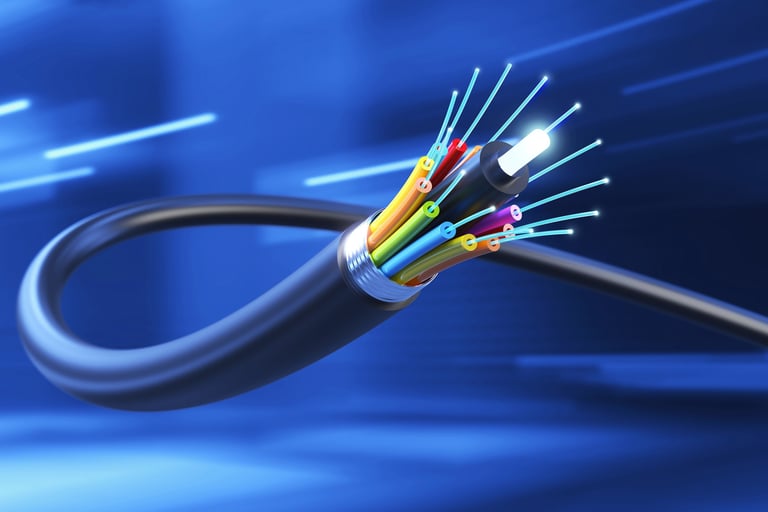Anhui Feichun Special Cable Co.,Ltd Li.wang@feichuncables.com
How Does Temperature Variation Affect Mining Cable Performance?
Discover how temperature fluctuations impact mining cable performance in South African operations. Learn about conductor resistance, insulation degradation, and solutions for harsh mining environments.
Li.wang@Feichun Cable
7/16/202510 min read


Temperature variation represents one of the most significant challenges facing mining cable systems across South Africa's diverse mining landscape. From the scorching heat of the Northern Cape's diamond mines to the frigid underground conditions of the Witwatersrand Basin, mining operations must contend with extreme temperature fluctuations that can severely impact cable performance and operational safety.
Mining cables serve as the lifeline of underground operations, carrying power to essential equipment, ventilation systems, and safety infrastructure. When temperature variations compromise these critical systems, the consequences can be catastrophic, affecting both productivity and worker safety. Understanding how temperature affects cable performance is essential for mining operators seeking to maintain reliable electrical distribution systems in South Africa's challenging mining environments.
The country's mining sector, which contributes significantly to the national economy, relies heavily on robust electrical infrastructure to support operations ranging from gold extraction in Gauteng to platinum mining in Limpopo. Recent incidents, including power failures at several major mining operations due to cable-related issues, have highlighted the critical importance of selecting appropriate cable systems that can withstand South Africa's extreme temperature variations.
The Impact of High Temperatures
High temperatures pose severe threats to mining cable performance, particularly affecting insulation materials and current-carrying capacity. When cables are exposed to excessive heat, the insulation materials undergo accelerated aging processes that significantly reduce their operational lifespan. This degradation occurs through thermal oxidation and polymer chain breakdown, leading to brittle insulation that becomes prone to cracking and electrical failure.
The current-carrying capacity of mining cables decreases substantially as ambient temperatures rise. This phenomenon, known as thermal derating, occurs because elevated temperatures reduce the cable's ability to dissipate heat effectively. In South Africa's deep-level mines, where ambient temperatures can exceed 40°C, this reduction in ampacity can severely limit the power available to critical mining equipment.
Overheating represents one of the most dangerous consequences of high-temperature exposure. When cables operate beyond their thermal limits, the risk of premature failure increases exponentially. This overheating can trigger cascading failures throughout the electrical system, potentially causing production shutdowns and safety hazards. The economic impact of such failures can be substantial, with some South African mining operations reporting losses of millions of rand due to cable-related downtime.
Copper conductors, commonly used in mining applications, exhibit increased electrical resistance as temperatures rise. This increased resistance generates additional heat, creating a self-perpetuating cycle that can lead to thermal runaway conditions. The phenomenon is particularly problematic in high-power applications where large currents flow through the conductors.
The Effects of Low Temperatures
Low temperatures present equally challenging conditions for mining cable performance, primarily affecting the mechanical properties of insulation and sheathing materials. When temperatures drop significantly, thermoplastic materials become increasingly brittle, making them susceptible to cracking under mechanical stress. This brittleness is particularly problematic during cable installation and maintenance operations in cold environments.
The risk of cracking and mechanical damage increases substantially in low-temperature conditions. Insulation materials that remain flexible at normal temperatures can become rigid and prone to fracture when exposed to extreme cold. This mechanical degradation can compromise the electrical integrity of the cable system, leading to ground faults and potential safety hazards.
Cable flexibility decreases dramatically in cold conditions, creating challenges during installation and maintenance procedures. Cables that are easily maneuvered at normal temperatures may become difficult to route through conduits or around equipment when temperatures drop. This reduced flexibility can lead to installation delays and increased labour costs, particularly in underground mining operations where access is limited.
The thermal shock experienced during cold start-ups can cause significant stress on cable systems. When equipment is started in cold conditions, the rapid temperature change can cause differential expansion between the conductor and insulation materials, potentially leading to internal damage that may not be immediately apparent but can cause premature failure over time.
Temperature Fluctuations and Their Dangers
Temperature fluctuations create perhaps the most insidious threats to mining cable performance through repeated expansion and contraction cycles. These thermal cycles cause micro-cracks to develop in insulation materials, gradually degrading the cable's electrical properties and reducing its operational lifespan. The cumulative effect of these thermal stresses can lead to catastrophic failures that occur without warning.
Electrical instability and arcing represent serious consequences of temperature-induced cable degradation. As insulation materials develop micro-cracks from thermal cycling, the electrical properties of the cable system become unstable, potentially leading to arcing faults that can cause fires or explosions in mining environments where flammable gases may be present.
A notable example of temperature-related cable failures occurred during shaft operations at several South African mines, where cables experienced significantly different failure rates during winter versus summer months. During winter operations, cables exhibited increased brittleness and mechanical failures, while summer conditions led to thermal degradation and overheating issues. These seasonal variations in failure patterns highlight the importance of designing cable systems that can withstand the full range of temperature conditions encountered in South African mining operations.
The expansion and contraction of cable materials during temperature fluctuations can also affect cable connections and terminations. Loose connections may develop over time as materials expand and contract, leading to increased resistance and potential hot spots that can cause system failures. This phenomenon is particularly problematic in underground mining environments where access for maintenance is limited and costly.
Mechanical Properties and Temperature Sensitivity
Heat significantly weakens the tensile strength of cable materials, affecting their ability to withstand mechanical stresses encountered during installation and operation. Elevated temperatures cause polymer chains in insulation materials to become more mobile, reducing the material's ability to resist deformation under load. This weakening effect can lead to cable damage during installation or when cables are subjected to mechanical stress during normal operations.
Cold conditions adversely affect impact resistance, making cables more susceptible to damage from falling objects or rough handling during installation. The increased brittleness of materials at low temperatures means that impacts that would normally cause minimal damage can result in significant cable failure. This vulnerability is particularly concerning in mining environments where cables may be exposed to falling rock or equipment impacts.
Temperature variations influence cable routing, support, and reeling systems in numerous ways. Cable support systems must be designed to accommodate thermal expansion and contraction, while reeling systems must account for changes in cable flexibility with temperature. Inadequate consideration of these thermal effects can lead to excessive stress on cables, resulting in premature failure and costly repairs.
The selection of appropriate cable support systems becomes critical in environments with significant temperature variations. Fixed supports that do not allow for thermal movement can create stress concentrations that lead to cable damage, while supports that provide inadequate restraint may allow excessive cable movement that can cause fatigue failures over time.
Conductor Resistance and Thermal Influence
The fundamental relationship between temperature and electrical resistance in copper conductors creates significant challenges for mining cable systems. As conductor temperature increases, electrical resistance rises proportionally, following the principle that resistance increases by approximately 0.393% per degree Celsius for copper. This temperature coefficient of resistance has profound implications for mining operations where power must be transmitted over long distances underground.
Energy losses and voltage drops increase substantially with rising conductor temperatures, reducing the efficiency of electrical transmission systems. These losses not only represent wasted energy but can also lead to inadequate voltage at equipment locations, potentially causing motors to draw excessive current and fail prematurely. The economic impact of these losses can be significant, particularly in energy-intensive mining operations.
Long-distance underground transmission systems are particularly vulnerable to temperature-related resistance increases. As cables carry current over hundreds of metres in underground mining operations, even small increases in resistance can result in substantial voltage drops and energy losses. This phenomenon can limit the distance over which power can be effectively transmitted, potentially requiring additional substations or higher voltage systems to maintain adequate power delivery.
The heat generated by current flow through resistance creates a self-reinforcing cycle where increased resistance leads to higher temperatures, which in turn increase resistance further. This thermal feedback loop can lead to runaway heating conditions that can cause catastrophic cable failure if not properly managed through appropriate cable sizing and thermal monitoring.
Solutions for Harsh South African Mining Environments
Selecting cables with wide temperature tolerance represents the first line of defense against temperature-related failures. SANS-compliant cable models specifically designed for South African mining conditions offer superior performance across the temperature ranges commonly encountered in local mining operations. These cables incorporate advanced materials and construction techniques that maintain their electrical and mechanical properties across wide temperature ranges.
Advanced materials such as Ethylene Propylene Rubber (EPR) insulation and Low Smoke Zero Halogen (LSZH) jackets provide superior temperature performance compared to traditional materials. EPR insulation maintains its flexibility and electrical properties across a wider temperature range than PVC alternatives, while LSZH jackets offer improved fire resistance and reduced toxic emissions in the event of a fire. These materials are particularly valuable in confined underground mining environments where safety is paramount.
Real-time temperature and load monitoring systems enable proactive management of cable thermal conditions. These systems can provide early warning of overheating conditions, allowing operators to take corrective action before failures occur. Advanced monitoring systems can integrate with mine automation systems to automatically adjust loads or activate cooling systems when temperature thresholds are approached.
Scheduled inspection and thermal scanning programmes help identify developing problems before they lead to failures. Infrared thermal imaging can detect hot spots in cable systems that may indicate developing faults, while visual inspections can identify physical damage that may compromise cable performance. Regular inspection schedules should account for the increased risk of temperature-related failures during extreme weather conditions.
The implementation of predictive maintenance strategies, supported by condition monitoring systems, can significantly reduce the risk of temperature-related cable failures. By tracking cable performance parameters over time, operators can identify degradation trends and schedule maintenance interventions before failures occur, reducing both downtime and maintenance costs.
Case Study: Deep-Level Platinum Mines in Limpopo
The platinum mines of Limpopo Province face unique temperature challenges that exemplify the importance of proper cable selection and management. These operations experience extreme temperature variations, with surface temperatures reaching 45°C in summer and underground temperatures varying significantly with depth and ventilation conditions. Recent expansions at several major platinum operations have highlighted the critical importance of temperature-resistant cable systems.
The Mogalakwena Mine, one of South Africa's largest platinum operations, has implemented comprehensive cable management strategies to address temperature challenges. The mine's electrical infrastructure must support operations from surface facilities exposed to extreme heat to underground workings where temperatures can vary by 20°C or more depending on depth and ventilation conditions.
Cable specifications chosen for these operations include EPR-insulated cables rated for continuous operation at 90°C, significantly higher than the 70°C rating of standard PVC cables. These cables utilize stranded copper conductors to improve flexibility and reduce stress concentrations, while LSZH outer sheaths provide improved fire resistance and reduced toxic emissions. The selection of these advanced materials has resulted in measurably improved reliability and reduced maintenance requirements.
Monitoring and maintenance practices at these operations include quarterly thermal imaging surveys, continuous temperature monitoring at critical locations, and proactive replacement of cables showing signs of thermal degradation. The implementation of these practices has reduced cable-related downtime by more than 40% compared to previous maintenance strategies, demonstrating the value of comprehensive temperature management approaches.
The success of these temperature management strategies has led to their adoption at other platinum operations in the region, with several mines reporting similar improvements in cable reliability and reductions in maintenance costs. The economic benefits of these improvements are substantial, with reduced downtime and maintenance costs more than offsetting the higher initial costs of advanced cable systems.
Best Practices for Mining Operators
Environmental risk assessment forms the foundation of effective cable temperature management. Mining operators should conduct comprehensive assessments of the temperature conditions their cable systems will encounter, including both normal operating conditions and extreme weather events. These assessments should consider seasonal variations, equipment heat generation, and the thermal characteristics of underground workings.
Cable lifecycle management strategies should account for the effects of temperature on cable aging and performance. This includes establishing replacement schedules based on thermal exposure history, implementing condition monitoring programmes to track cable degradation, and maintaining spare cable inventory appropriate for the specific temperature conditions encountered at each operation.
Collaboration with cable manufacturers for site-specific designs represents a critical best practice for addressing unique temperature challenges. Manufacturers can provide valuable expertise in material selection, construction techniques, and performance optimization for specific operating conditions. This collaboration should begin during the design phase and continue throughout the cable lifecycle to ensure optimal performance.
Training programmes for maintenance personnel should emphasize the importance of temperature considerations in cable installation, operation, and maintenance. Personnel should understand how temperature affects cable performance and be equipped with appropriate tools and procedures for monitoring and managing thermal conditions. Regular refresher training should ensure that knowledge remains current with evolving best practices and technologies.
The establishment of temperature-based operating procedures can help prevent temperature-related failures. These procedures should include guidelines for cable loading under various temperature conditions, protocols for responding to high-temperature alarms, and procedures for inspecting cables after extreme temperature events. Clear procedures help ensure consistent application of temperature management practices across all operations.
FAQ
Q: What is the maximum operating temperature for mining cables? A: Standard mining cables are typically rated for continuous operation at 70°C to 90°C depending on insulation type, though specialty cables can operate at higher temperatures. EPR-insulated cables generally offer higher temperature ratings than PVC alternatives.
Q: How does altitude affect cable temperature performance in South African mines? A: Higher altitudes reduce air density, which decreases cooling efficiency and can lead to higher cable operating temperatures. This is particularly relevant for surface installations at high-altitude mining operations in regions like the Highveld.
Q: What monitoring equipment is recommended for temperature management? A: Infrared thermal imaging cameras, continuous temperature monitoring systems, and load monitoring equipment are essential tools for effective temperature management in mining cable systems.
Q: How often should thermal inspections be conducted? A: Thermal inspections should be conducted quarterly under normal conditions, with increased frequency during extreme weather periods or when operating conditions change significantly.
Q: What are the signs of temperature-related cable damage? A: Signs include discoloured insulation, brittle or cracked sheathing, increased electrical resistance, and abnormal heating detected through thermal imaging. Any of these signs warrant immediate investigation and potential cable replacement.
Conclusion
Temperature variation represents one of the most significant challenges facing mining cable systems in South Africa's diverse and demanding mining environments. The effects of both high and low temperatures, combined with the damaging impact of thermal cycling, create complex challenges that require comprehensive management strategies to ensure reliable electrical distribution in mining operations.
The success of temperature management strategies depends on a combination of proper cable selection, advanced materials, comprehensive monitoring systems, and proactive maintenance practices. The experiences of South African mining operations, particularly in the platinum sector, demonstrate that effective temperature management can significantly improve cable reliability while reducing maintenance costs and operational downtime.
As South Africa's mining industry continues to evolve, with operations extending to greater depths and more challenging environments, the importance of temperature-resistant cable systems will only increase. Mining operators who invest in comprehensive temperature management strategies today will be better positioned to maintain reliable operations and competitive advantages in the future.
The key to success lies in understanding that temperature management is not simply about selecting the right cables, but about implementing comprehensive strategies that address all aspects of cable performance in varying thermal conditions. Through proper planning, material selection, monitoring, and maintenance, mining operations can minimize the risks associated with temperature variation and ensure reliable electrical distribution systems that support safe and productive mining operations across South Africa's challenging mining environments.





Email Address: Li.wang@feichuncables.com
© 2025. All rights reserved.


One-click to Quickly Contact
Products
Offshore & Marine Cable
XLPE Cable
Contact
Company
Location:
Building A Private Science and Technology Park, Hefei Economic and Technological Development Zone, Anhui Province, China
